
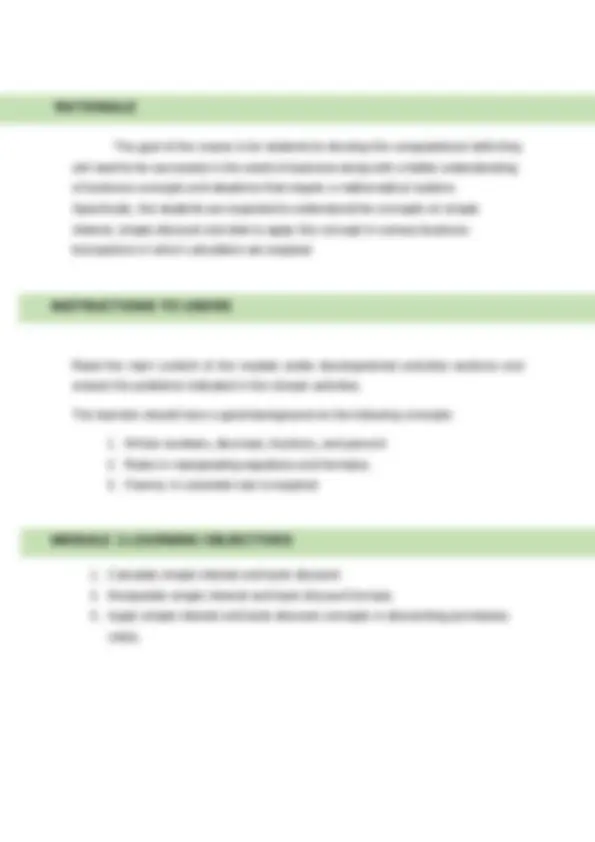

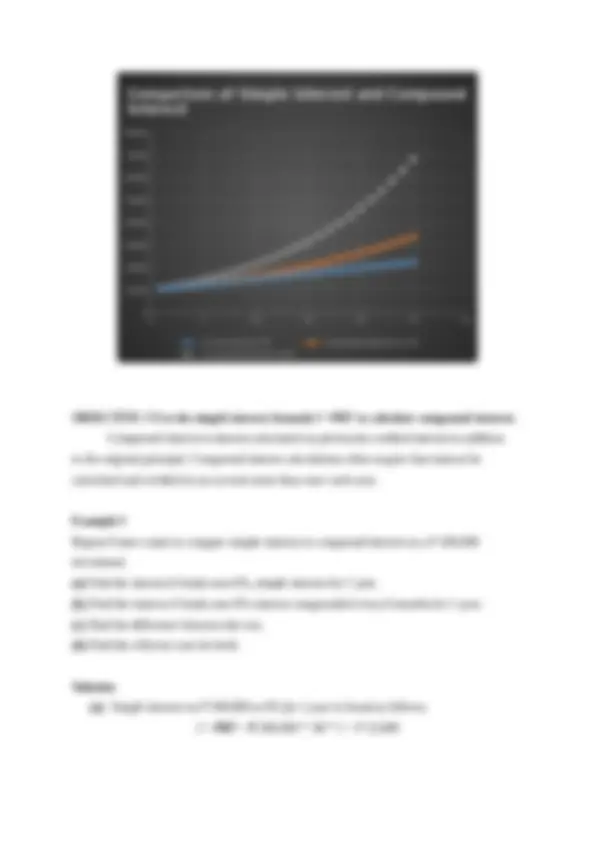
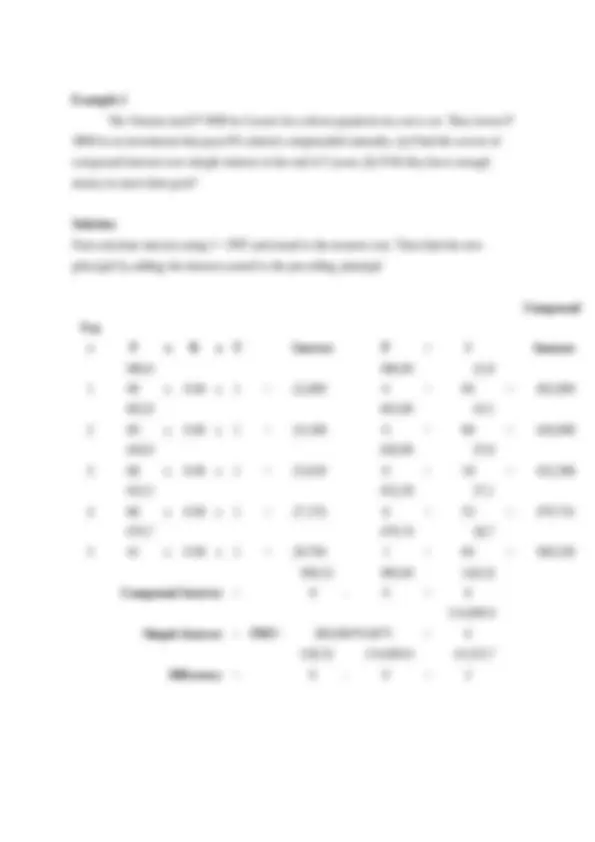
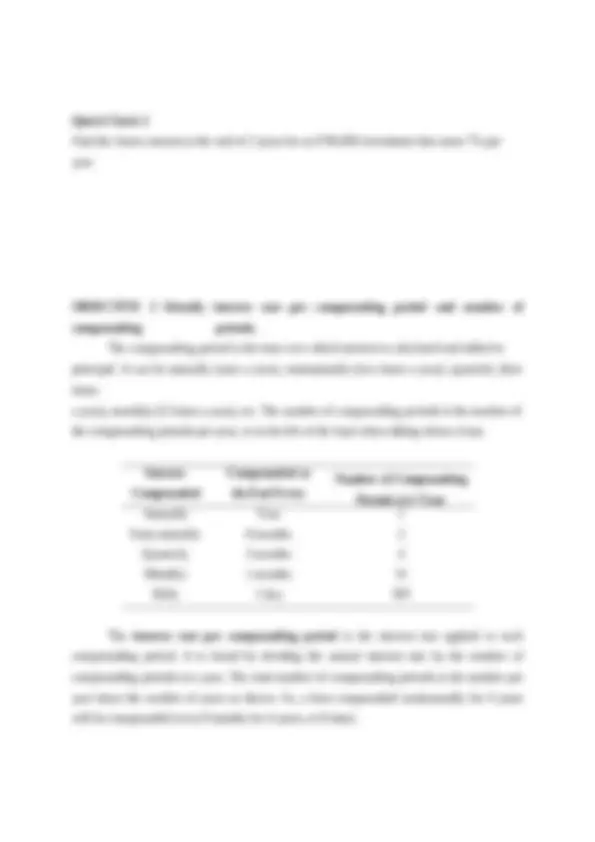
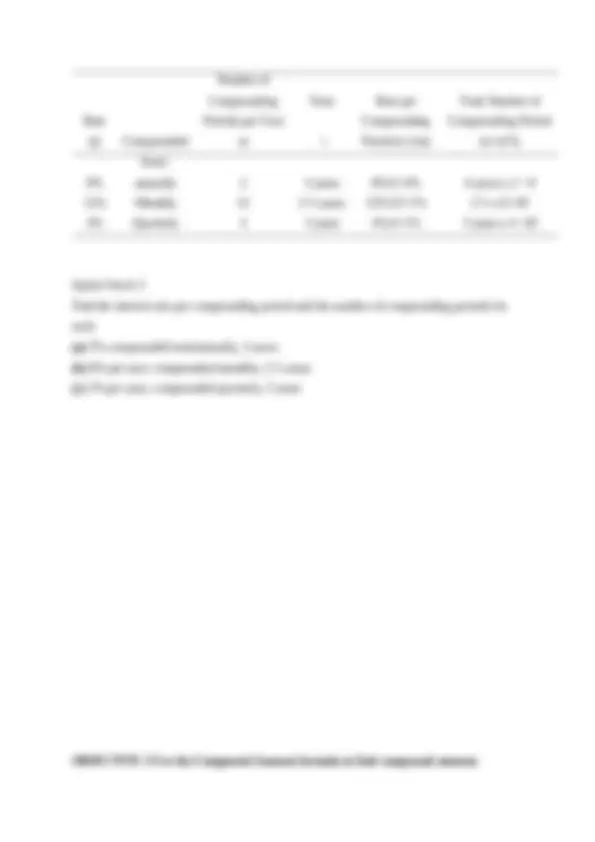
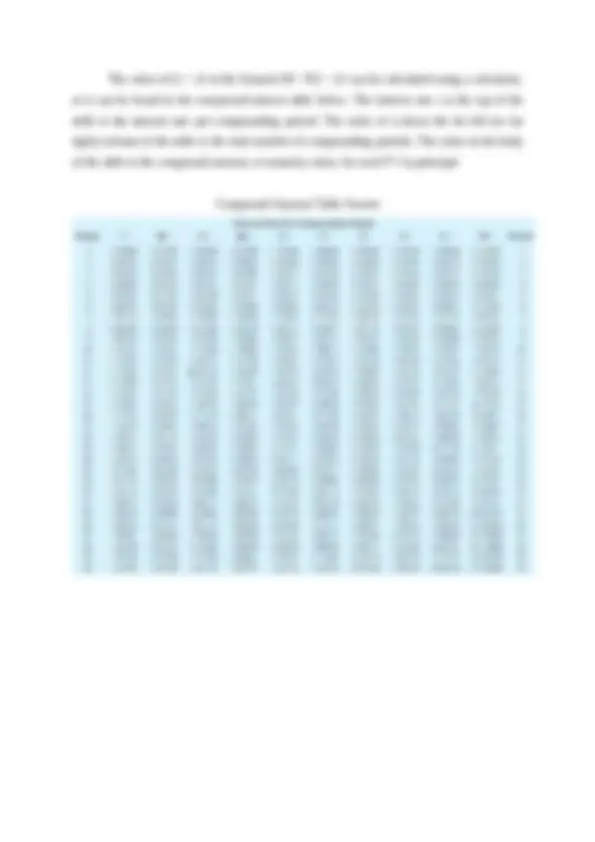
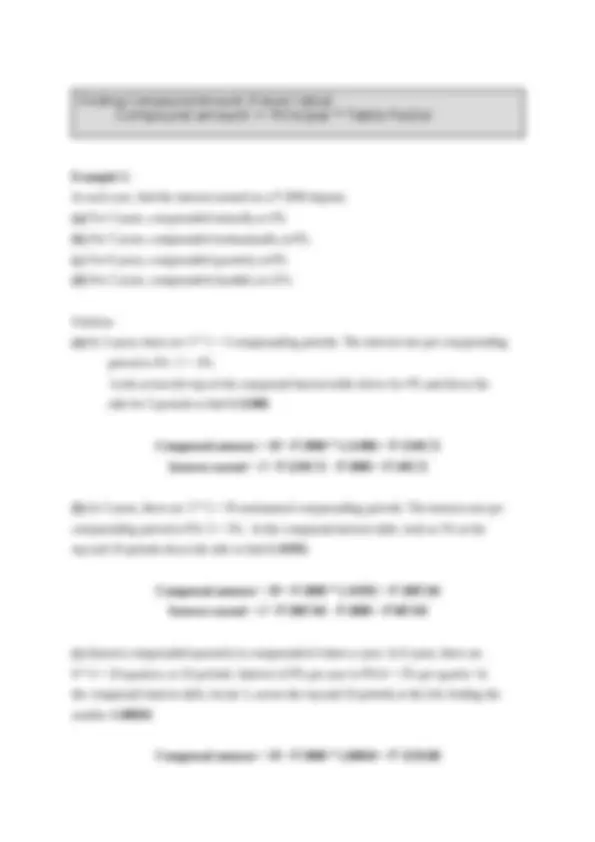
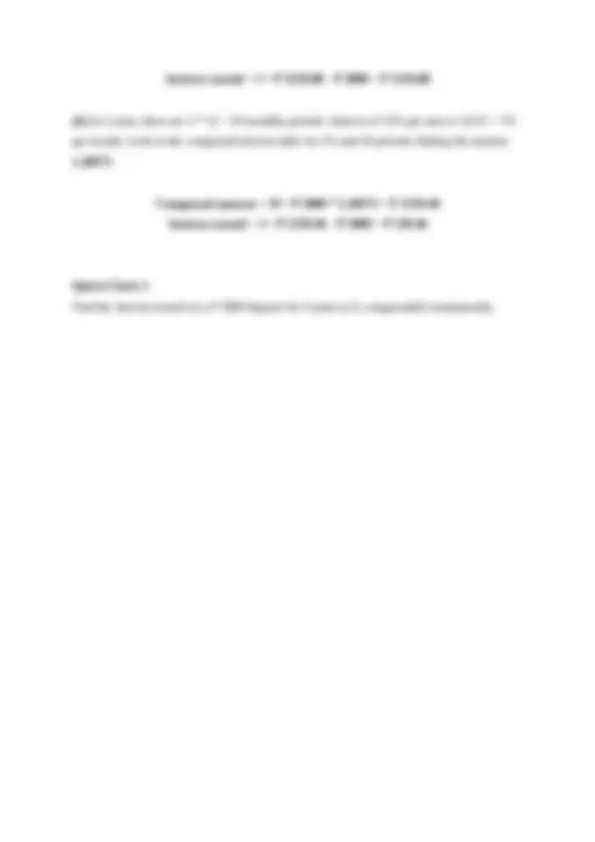
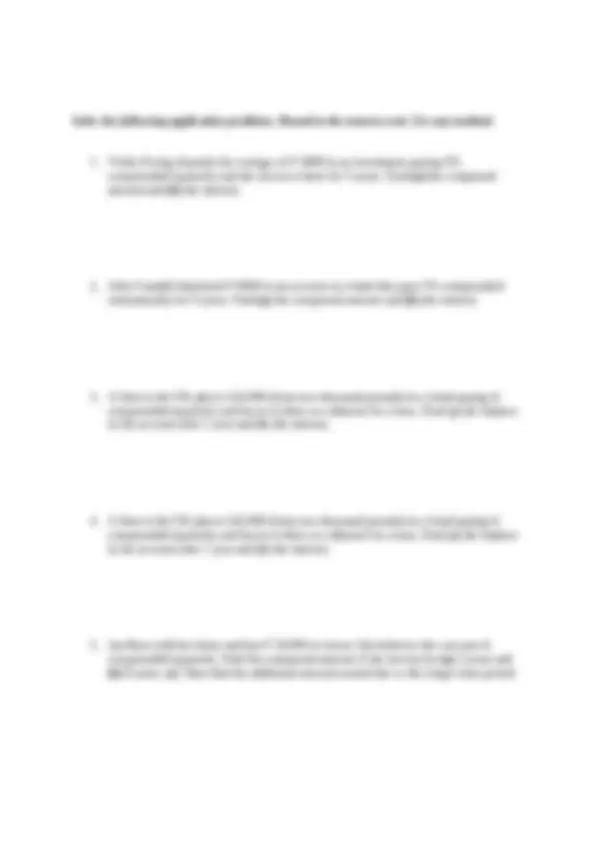
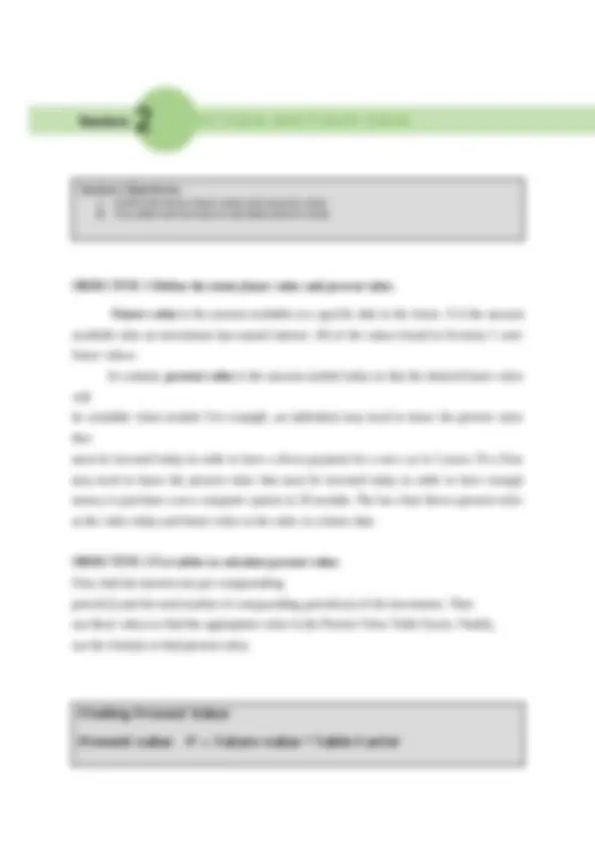
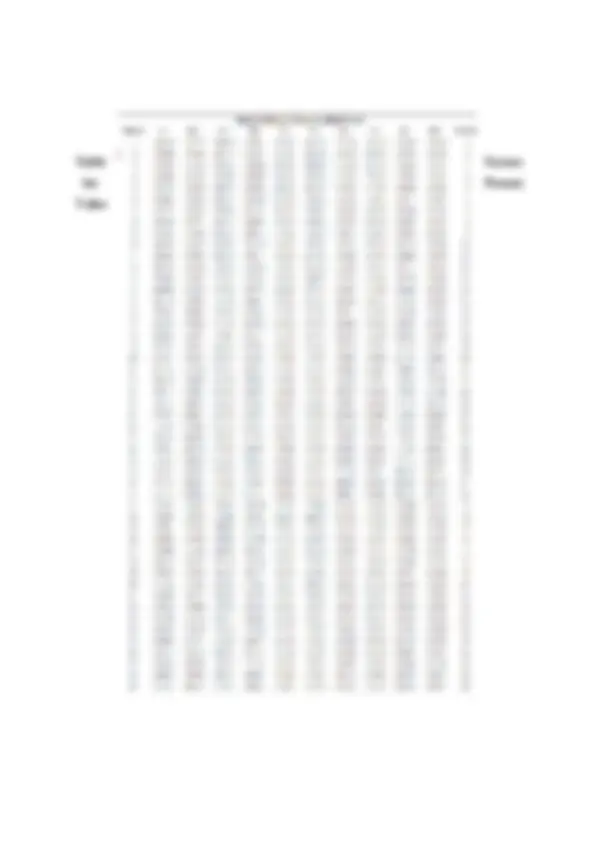
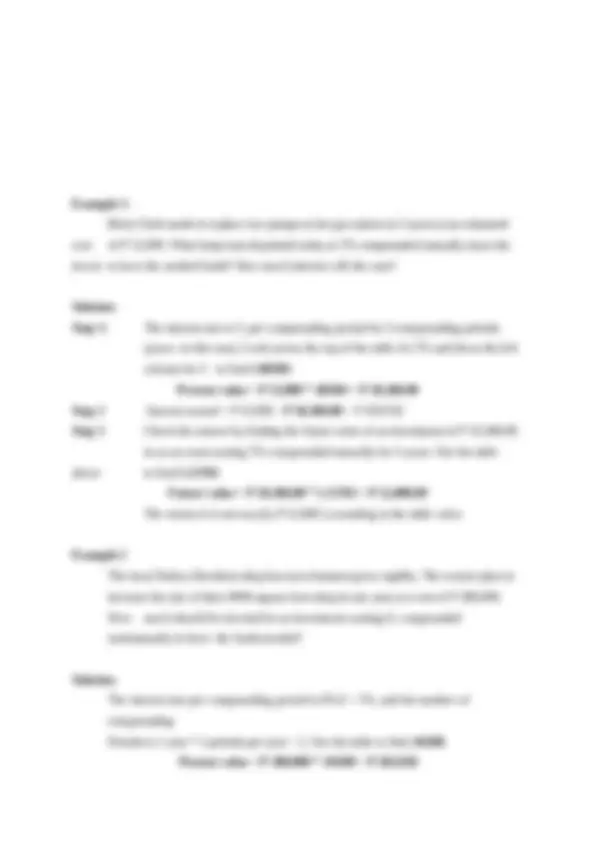
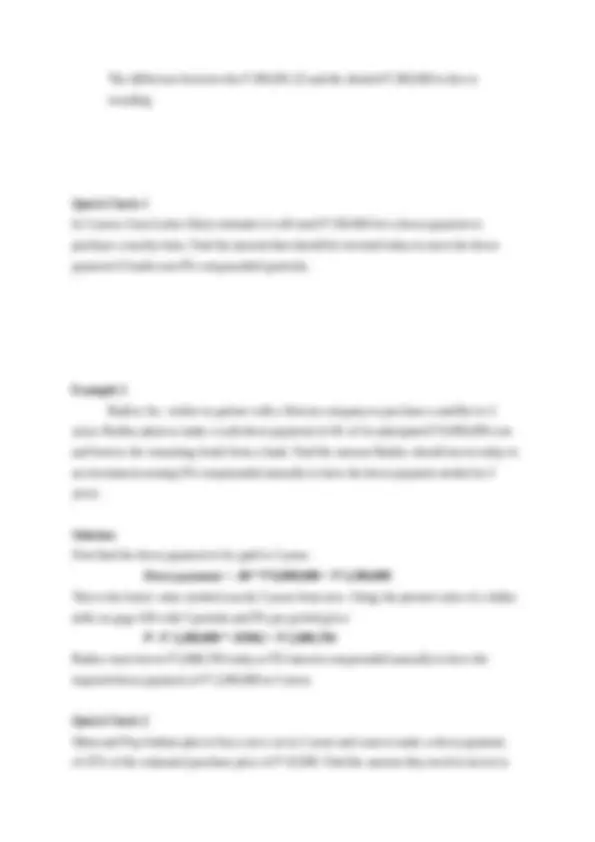
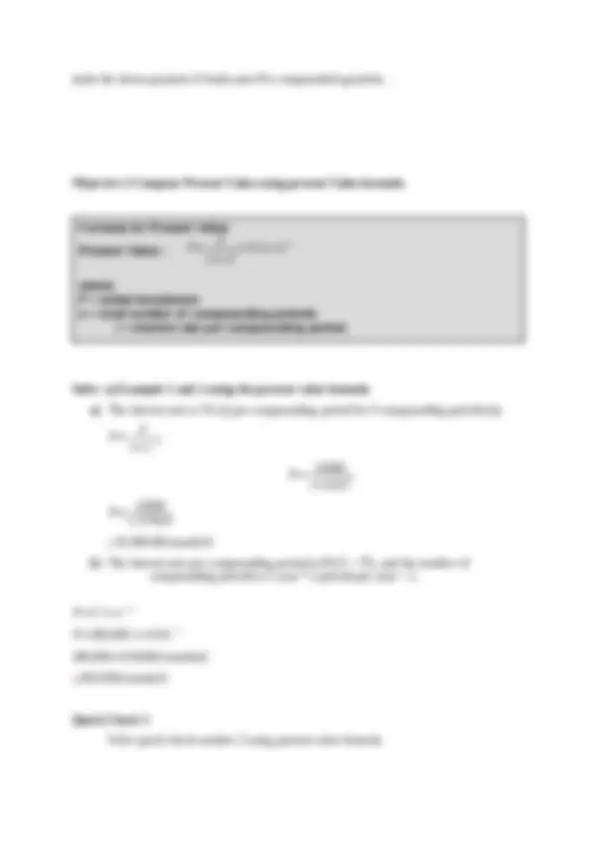
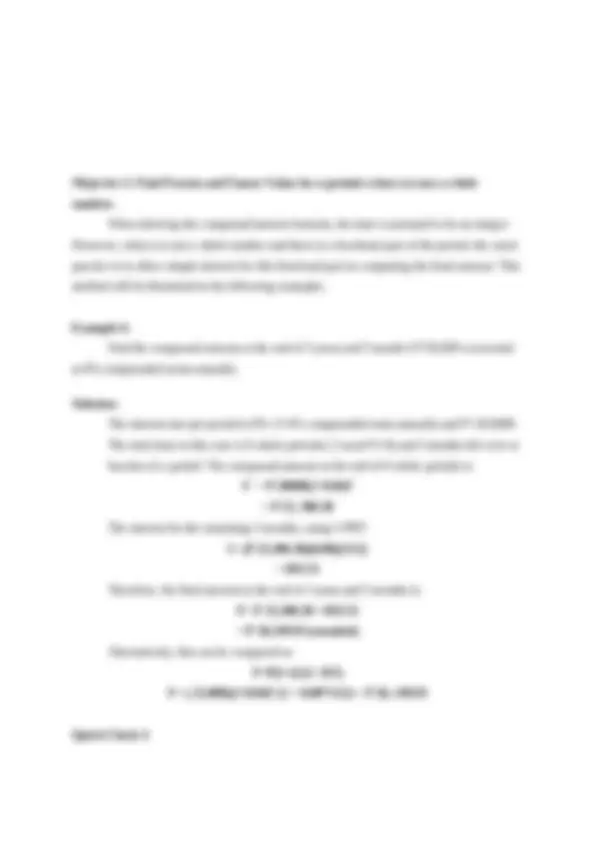
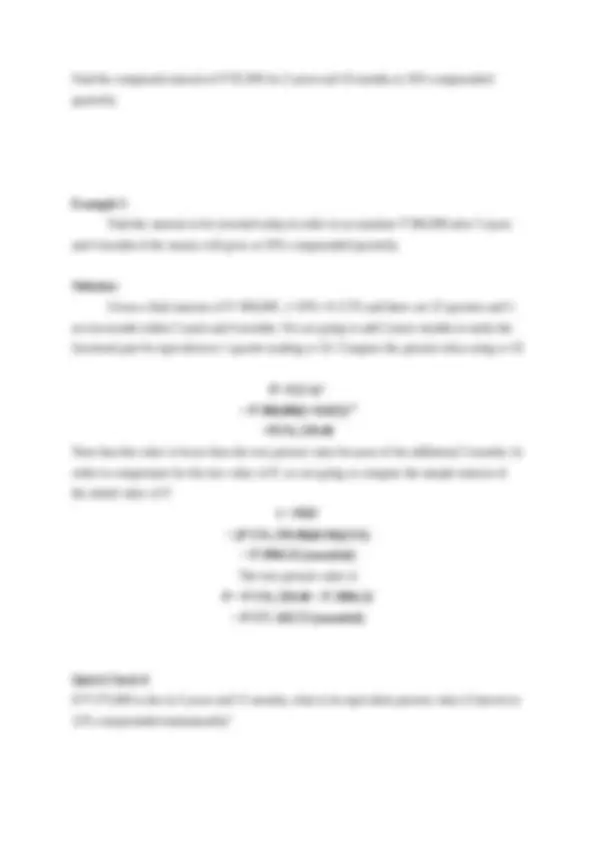
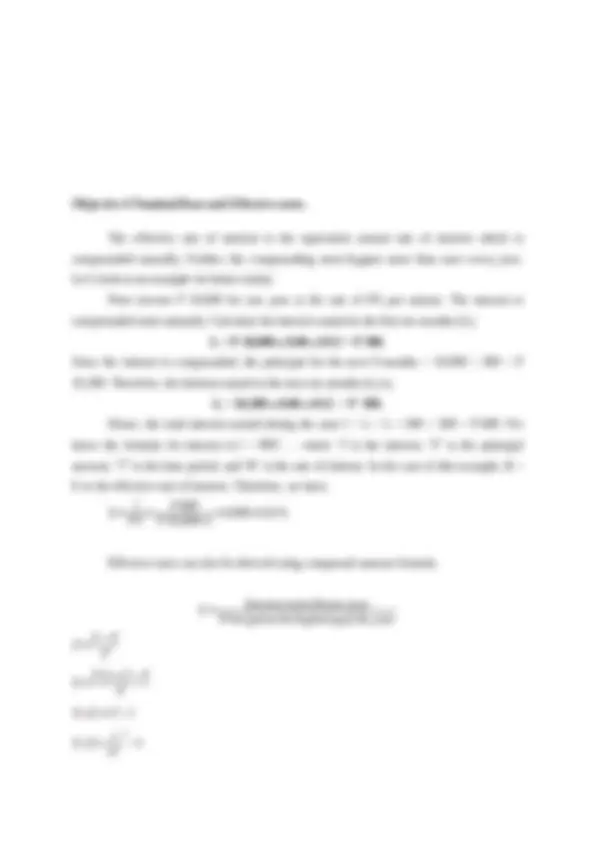
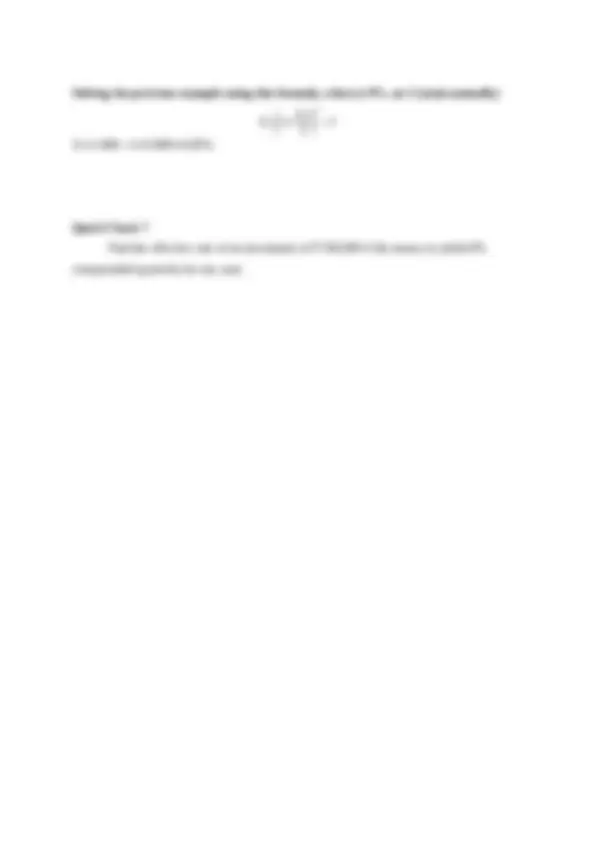
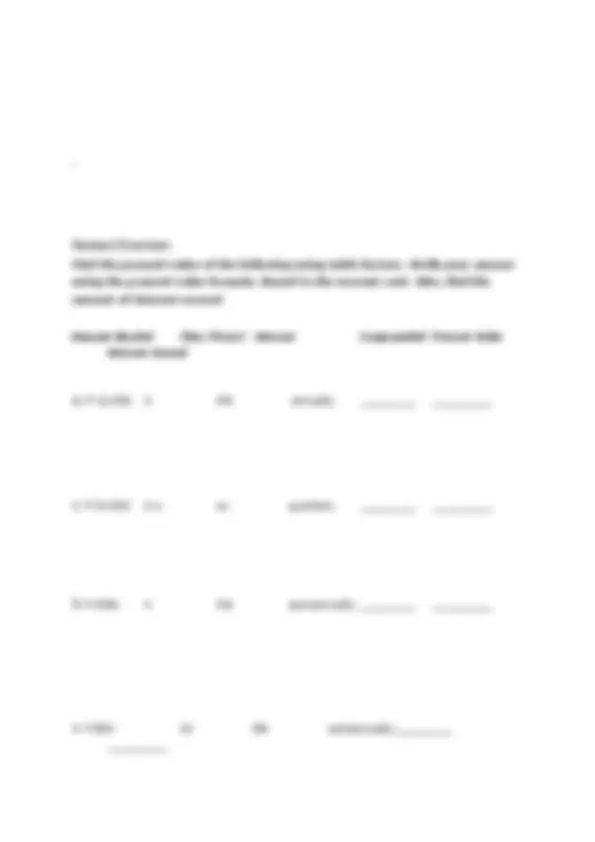
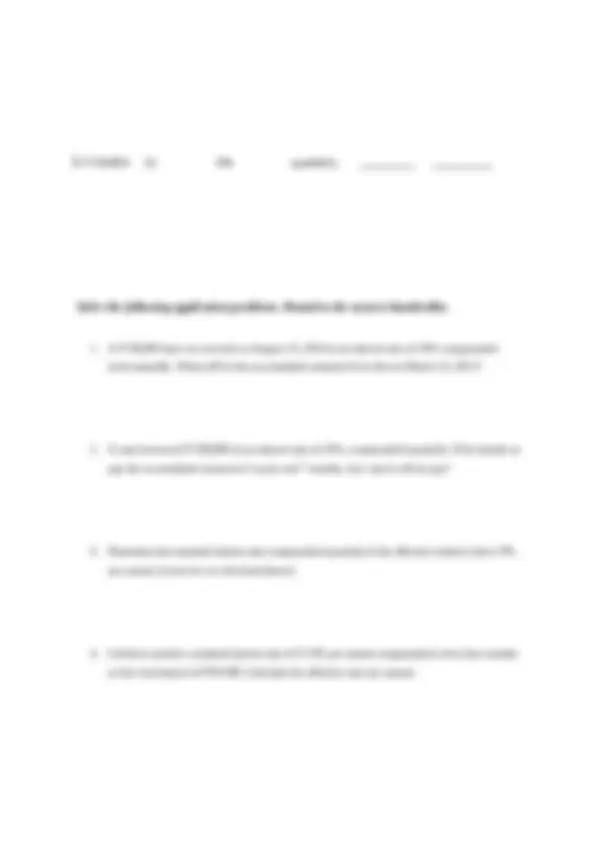
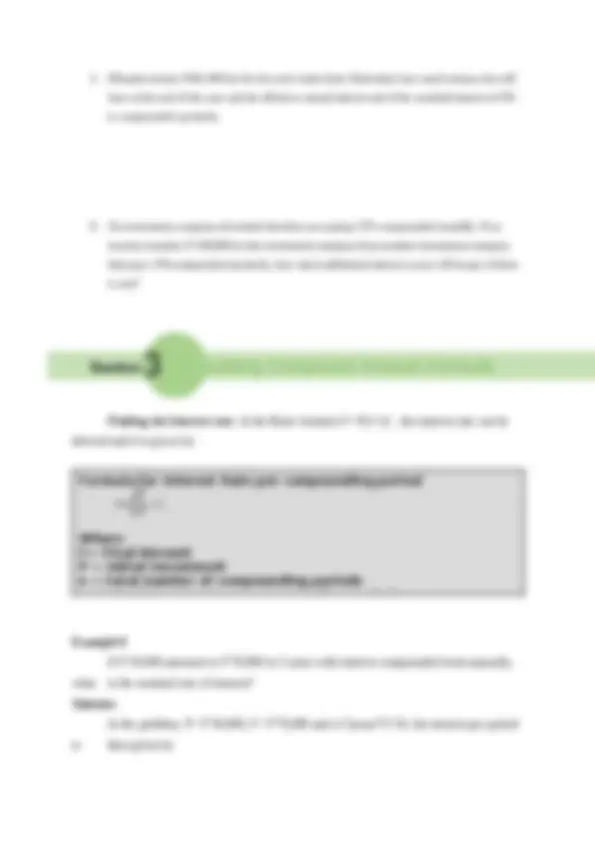
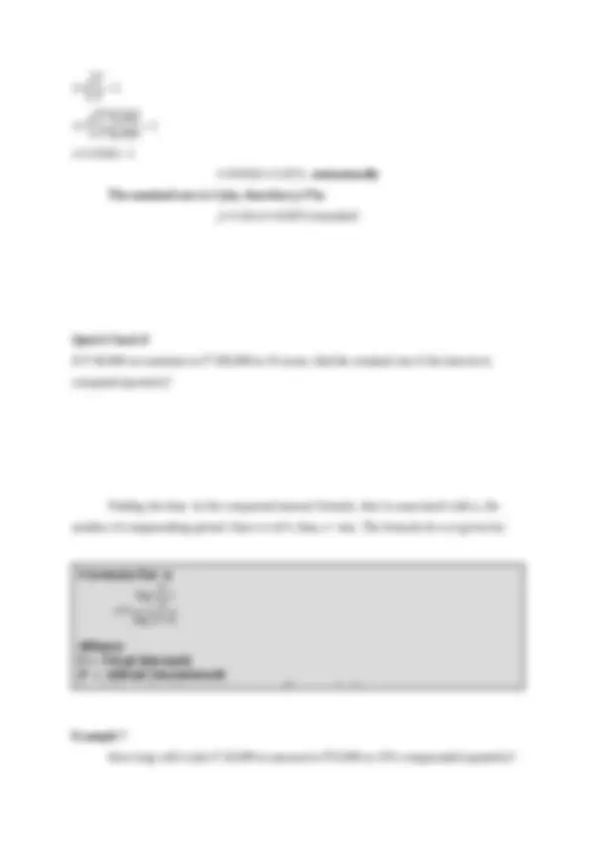
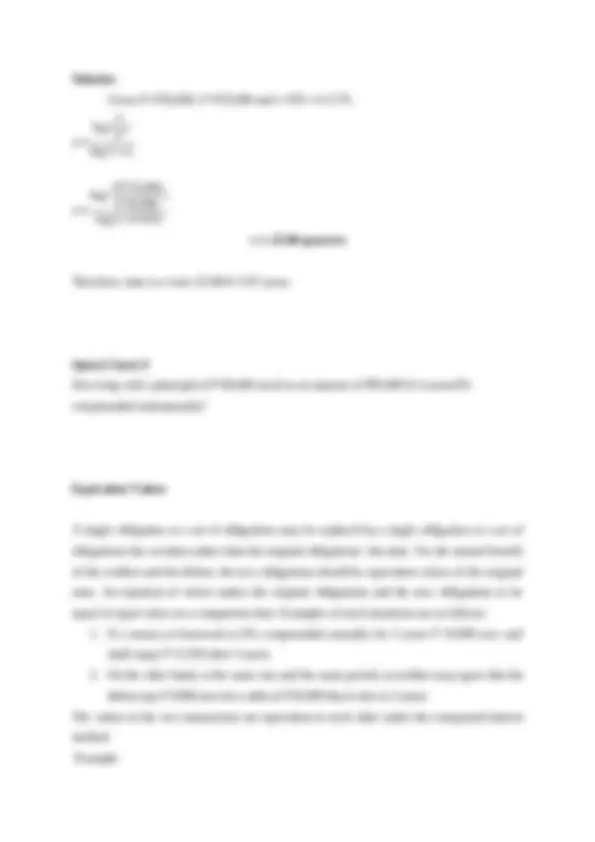
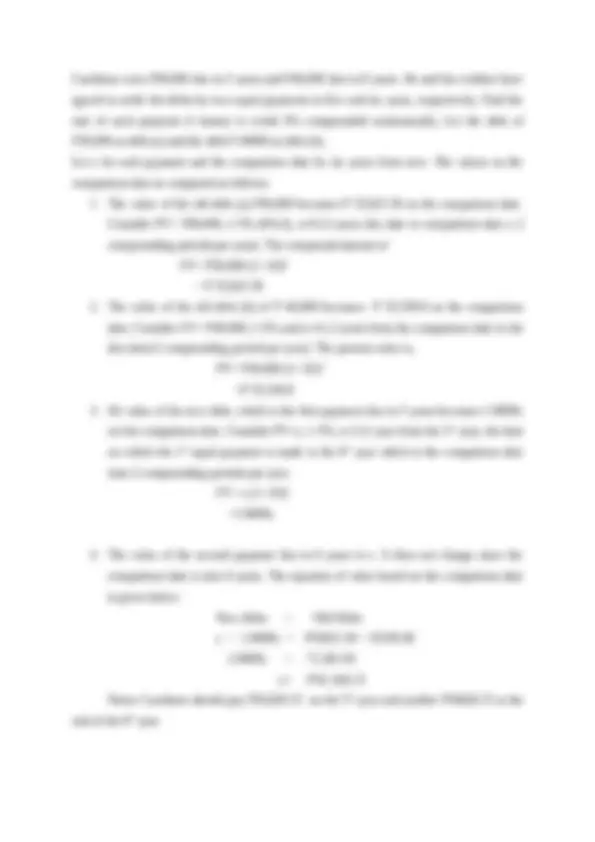
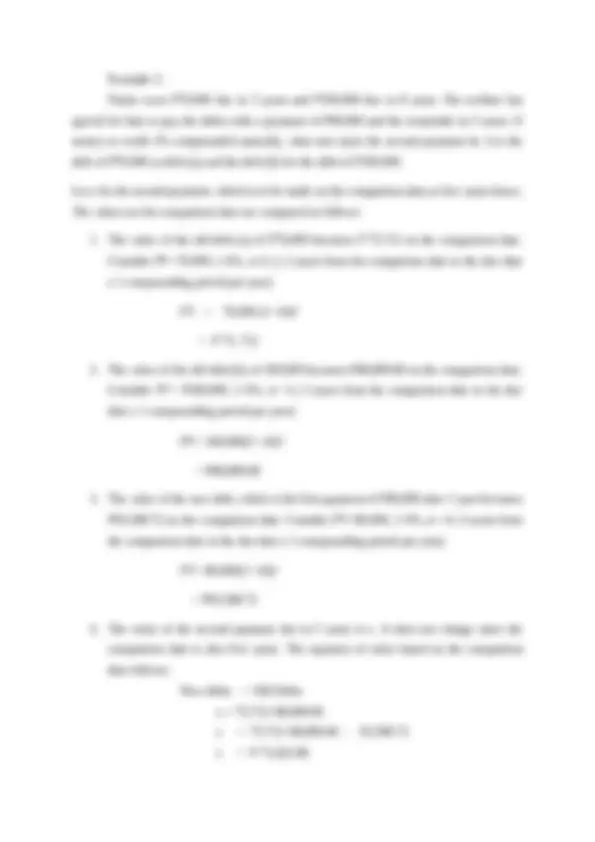
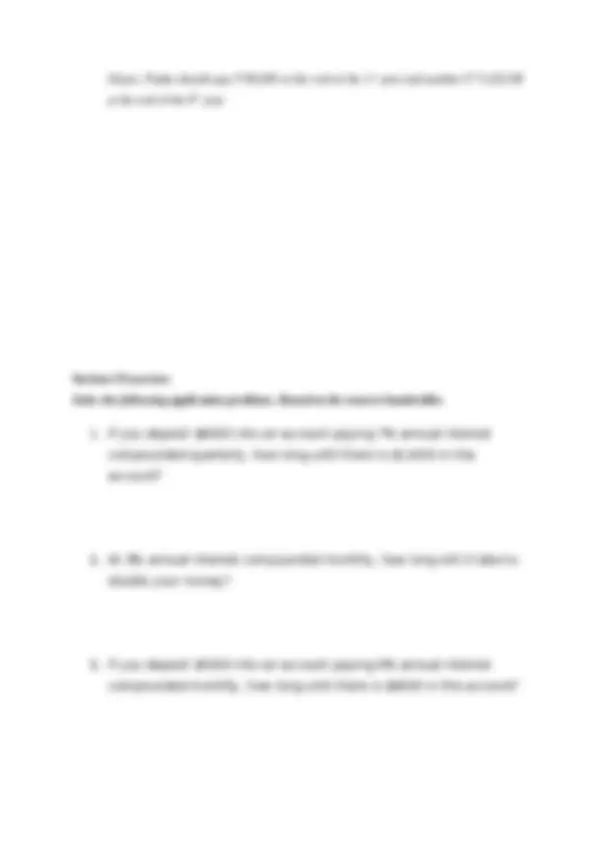
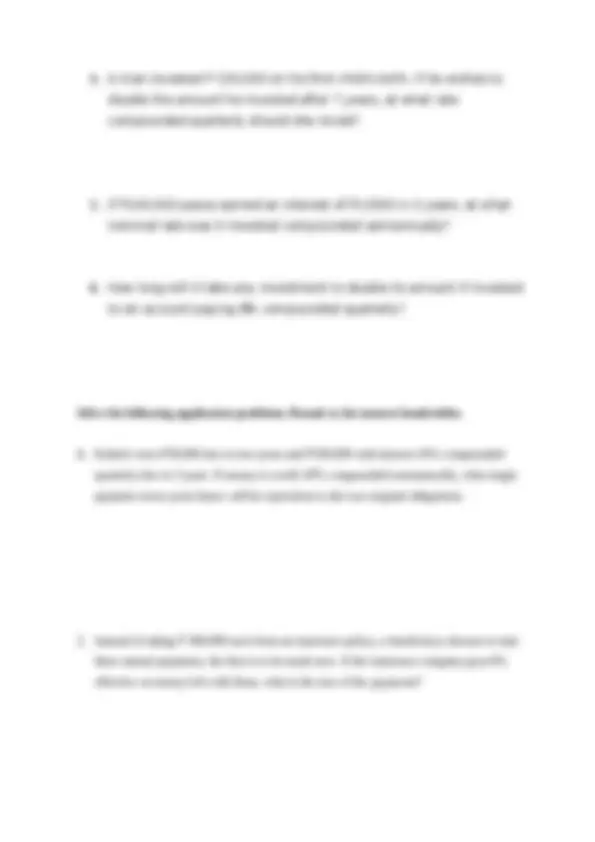
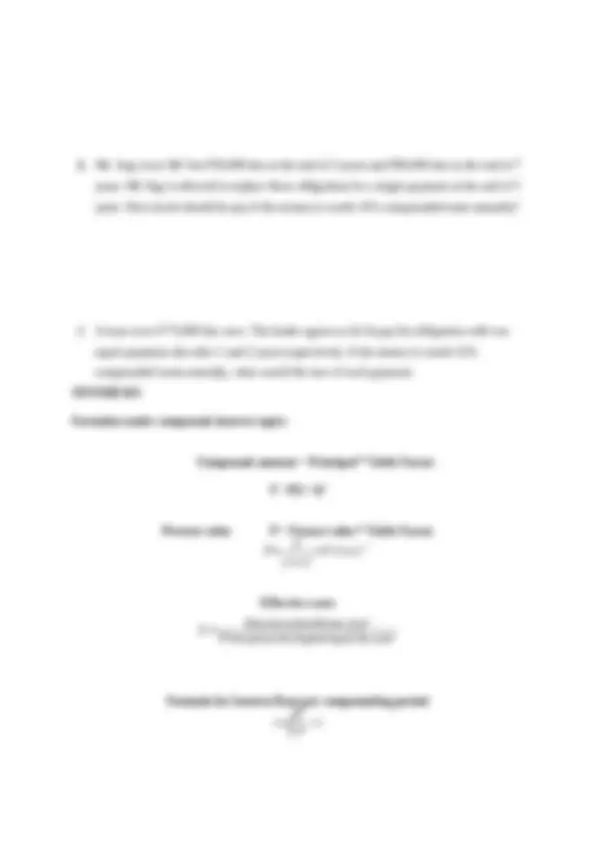
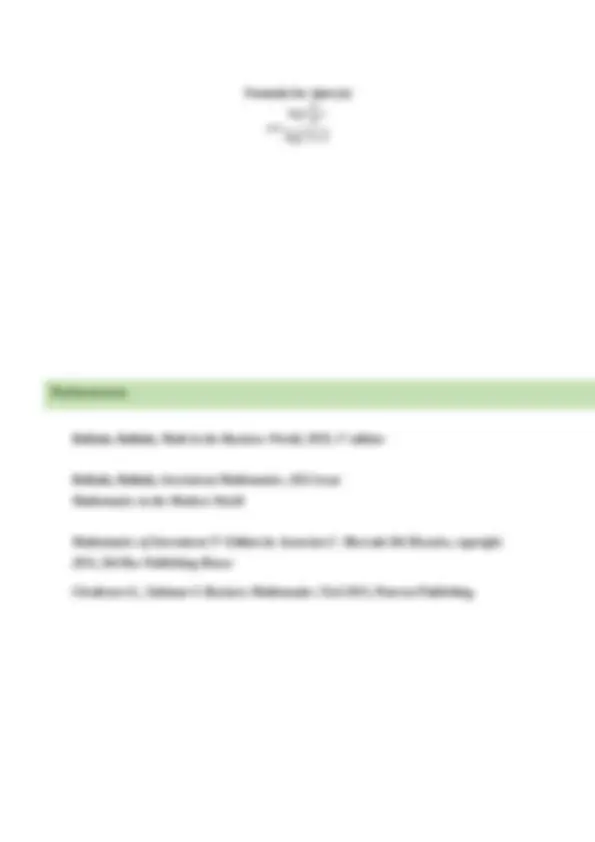


Study with the several resources on Docsity

Earn points by helping other students or get them with a premium plan


Prepare for your exams
Study with the several resources on Docsity

Earn points to download
Earn points by helping other students or get them with a premium plan
Community
Ask the community for help and clear up your study doubts
Discover the best universities in your country according to Docsity users
Free resources
Download our free guides on studying techniques, anxiety management strategies, and thesis advice from Docsity tutors
Mathematics in the modern World
Typology: Study notes
1 / 38

This page cannot be seen from the preview
Don't miss anything!































Compound Interest Section 1 Relation of Compound Interest to Simple Interest Section 2 Present Value and Future Value Section 3 Manipulating Compound Amount Formula and Equivalent Values
Present value is the value of an investment today, right now. Money left in an investment usually grows over time. The amount in an investment at a specific future date is called the future amount , compound amount , or future value. The future value depends not only on the amount initially invested, it also depends on the following:
**1. Compound interest—Compound interest results in a greater future value than simple interest.
Section Objectives:
0 5 10 15 20 25 30 0 10000 20000 30000 40000 50000 60000 70000 80000 Comparison of Simple interest and Compound Interest Simple Interest 5% Compound Interest at 5% Compound Interest at 8% OBJECTIVE 1 Use the simple interest formula I = PRT to calculate compound interest. Compound interest is interest calculated on previously credited interest in addition to the original principal. Compound interest calculations often require that interest be calculated and credited to an account more than once each year. Example 1 Regina Foster wants to compare simple interest to compound interest on a P 200, investment. (a) Find the interest if funds earn 6%, simple interest for 1 year. (b) Find the interest if funds earn 6% interest compounded every 6 months for 1 year. (c) Find the difference between the two. (d) Find the effective rate for both. Solution (a) Simple interest on P 200,000 at 6% for 1 year is found as follows. I = PRT = P 200,000 * .06 * 1 = P 12,
Quick Check 1 P 15,000 is invested for 1 year. Find the future value based on (a) simple interest of 8, and (b) 8, interest compounded every 6 months. (c) Then find the difference between the two. Finding Future Value (Compound Amount)
1. Use I = PRT to find simple interest for the period. 2. Add principal at the end of the previous period to the interest for the current period to find the principal at the end of the current period.
Example 2 The Simons need P 5000 in 4 years for a down payment on a new car. They invest P 3800 in an investment that pays 6% interest compounded annually. (a) Find the excess of compound interest over simple interest at the end of 5 years. (b) Will they have enough money to meet their goal? Solution First calculate interest using I = PRT and round to the nearest cent. Then find the new principal by adding the interest earned to the preceding principal Compound Yea r P x R x T Interest P + I Amount 1
00 x 0.06 x 1 = 22,
00 x 0.06 x 1 = 24,
68 x 0.06 x 1 = 25,
86 x 0.06 x 1 = 27,
41 x 0.06 x 1 = 28,
Compound Interest =
Simple Interest = PRT= 380,0000.065 =
Difference =
Number of Compounding Term Rate per Total Number of Rate (j) Compounded Periods per Year m t Compounding Period (i=j/m) Compounding Period (n=m*t) 8% Semi- annually 2 4 years 8%/2=4% 4 years x 2 = 8 12% Monthly 12 2 ½ years 12%/12=1% 2 ½ x12= 4% Quarterly 4 5 years 4%/4=1% 5 years x 4 = Quick Check 3 Find the interest rate per compounding period and the number of compounding periods for each. (a) 5% compounded semiannually, 3 years (b) 6% per year, compounded monthly, 2 ½ years (c) 2% per year, compounded quarterly, 5 years OBJECTIVE 3 Use the Compound Amount formula to find compound amount.
Example 3: An investment managed by Bank of America pays 7% interest per year compounded semiannually. Given an initial deposit of P 4500, (a) use the formula to find the compound amount after 5 years, and (b) find the compound interest. Solution Interest is compounded at 7% /2 = 3.5% every 6 months for 5 years * 2 periods per year = periods. Therefore, 3.5% is the interest rate per compounding period ( i ) and 10 is the number of compounding periods ( n ). M = P ( 1 + i ) n = P 4500 * (1 + .035)^10 = P 4500 * (1.035)^10 = P 6347.69 (rounded) The compound amount is P 6347.69. I = M - P = P 6347.69 - P 4500 = P 1847. The interest is P 1847. Quick Check 4 Formulas for Compounding Interest Maturity value/Future Value: F = P ( 1 + i )n Interest: I = F - P where P = initial investment n = total number of compounding periods i = interest rate per compounding period
The value of (1 + i)n^ in the formula M = P(1 + i)n^ can be calculated using a calculator, or it can be found in the compound interest table below. The interest rate i at the top of the table is the interest rate per compounding period. The value of n down the far left (or far right) column of the table is the total number of compounding periods. The value in the body of the table is the compound amount, or maturity value, for each P 1 in principal. Compound Amount Table Factors
Example 5: In each case, find the interest earned on a P 2000 deposit. (a) For 3 years, compounded annually at 4% (b) For 5 years, compounded semiannually at 6% (c) For 6 years, compounded quarterly at 8% (d) For 2 years, compounded monthly at 12% Solution (a) In 3 years, there are 3 * 1 = 3 compounding periods. The interest rate per compounding period is 4% / 1 = 4% Look across the top of the compound interest table above for 4% and down the side for 3 periods to find 1.. Compound amount = M = P 2000 * 1.12486 = P 2249. Interest earned = I = P 2249.72 - P 2000 = P 249. (b) In 5 years, there are 5 * 2 = 10 semiannual compounding periods. The interest rate per compounding period is 6%/ 2 = 3%. In the compound interest table, look at 3% at the top and 10 periods down the side to find 1.. Compound amount = M = P 2000 * 1.34392 = P 2687. Interest earned = I = P 2687.84 - P 2000 = P 687. (c) Interest compounded quarterly is compounded 4 times a year. In 6 years, there are 6 * 4 = 24 quarters, or 24 periods. Interest of 8% per year is 8%/4 = 2% per quarter. In the compound interest table, locate 2, across the top and 24 periods at the left, finding the number 1.. Compound amount = M = P 2000 * 1.60844 = P 3216. Finding Compound Amount (Future Value)
Section 1 Exercises. Provide a Concise solution as indicated in the example. Use the formula for compound amount, not the table, to find the compound amount and interest. Round to the nearest cent Compound Amount Interest
1. P 12,000 at 8% compounded annually for 4 years P 16,325.87 P 4325. Compound interest is 8% per year for 4 years. F = P 12,000 * (1 + .08) 4 = P 16,325. I = P 16,325.87 - P 12,000 = P 4325. 2. P 14,800 at 6% compounded semiannually for 4 years ________ _________
3. P 12,300 at 3% compounded semiannually for 4 years__________ __________ 4. P 12,500 at 8% compounded quarterly for 5 years __________ __________ Find the simple interest for the period indicated. Then use table values to find the compound interest. Finally, find the difference between compound interest and simple interest. Round each to the nearest cent. (Interest is compounded annually.) Number Simple Compound Principal Rate of Years Interest Interest Difference 1. P 5400 6% 4 _________ __________ _____________ 2. P 9200 5% 6 _________ __________ _____________ 3. P 1200 8% 15 _________ __________ _____________ 4. P 4625 4% 10 _________ __________ _____________
OBJECTIVE 1 Define the terms future value and present value****. Future value is the amount available at a specific date in the future. It is the amount available after an investment has earned interest. All of the values found in Sections 1 were future values. In contrast, present value is the amount needed today so that the desired future value will be available when needed. For example, an individual may need to know the present value that must be invested today in order to have a down payment for a new car in 3 years. Or a firm may need to know the present value that must be invested today in order to have enough money to purchase a new computer system in 20 months. The bar chart shows present value as the value today and future value as the value at a future date. OBJECTIVE 2 Use tables to calculate present value. First, find the interest rate per compounding period ( i ) and the total number of compounding periods ( n ) of the investment. Then use these values to find the appropriate value in the Present Value Table Factor. Finally, use the formula to find present value.
Section Objectives:
Table Factors for Present Value